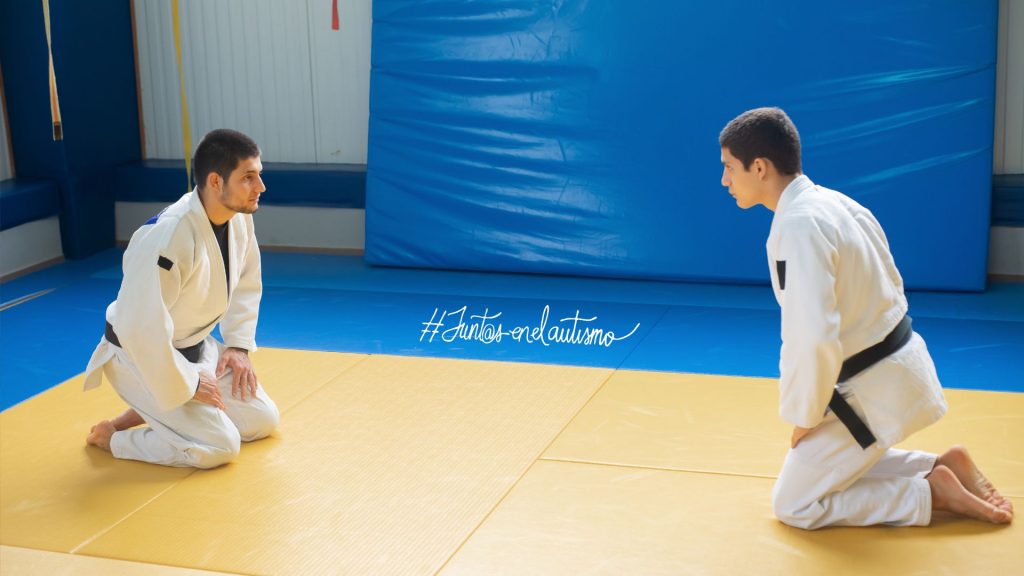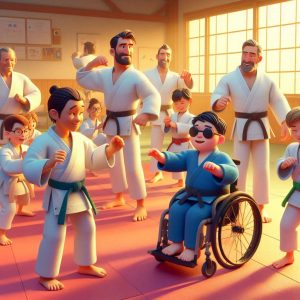Efectos de un programa de Judo de 8 semanas sobre el comportamiento en niños con Trastorno del Espectro Autista (TEA): un enfoque de métodos mixtos

Paola Rivera, Justine Renziehausen, Jeanette M. García
Estudios previos sugieren que una combinación de actividad física y ejercicios de mente y cuerpo, a menudo vistos en las artes marciales, puede atenuar los comportamientos negativos en jóvenes con Trastorno del Espectro Autista (TEA). Por lo tanto, el objetivo de este estudio fue examinar los efectos de un programa de judo de 8 semanas sobre los factores conductuales en niños con TEA, utilizando un enfoque de métodos mixtos. Un total de 25 niños (de 8 a 17 años), diagnosticados con TEA, participaron en un programa de judo de 8 semanas (1 × semana). Los padres de los participantes recibieron la Lista de Verificación de Comportamiento Aberrante (ABC) para comparar la gravedad del comportamiento relacionado con el TEA al inicio y al final del programa. Un subconjunto de padres (n = 9) participó en entrevistas semiestructuradas que se centraron en los comportamientos de sus hijos durante el programa de judo. Se realizaron pruebas t pareadas no paramétricas para comparar las diferencias en las puntuaciones ABC desde el inicio y al final del programa. Las entrevistas fueron codificadas de forma independiente por dos investigadores capacitados y clasificadas en temas de comportamiento. Los participantes asistieron a un promedio de 7,04 ± 1,06 clases (de 8 sesiones). No hubo cambios significativos en las puntuaciones ABC, sin embargo, las entrevistas con los padres revelaron que el 78 % de los padres observaron mejoras tanto en las habilidades sociales como en la autoestima como resultado del programa de judo. A pesar de que no hay diferencias significativas en las puntuaciones ABC antes y después del judo, los datos de las entrevistas con los padres indican mejoras en la autoestima y las habilidades sociales. Los estudios futuros deberían examinar más a fondo los efectos del judo en una muestra más grande de jóvenes con TEA e incluir condiciones de control (p. ej., grupo sin ejercicio) con fines comparativos.

Referencias
- CDC (2018) Data and statistics|Autism Spectrum Disorder (ASD)|NCBDDD|CDC. https://www.cdc.gov/ncbddd/autism/data.html. Accessed 25 June 2018
- Srinivasan SM, Pescatello LS, Bhat AN (2014) Current perspectives on physical activity and exercise recommendations for children and adolescents with Autism Spectrum Disorders. Phys Ther 94:875–889
- Richdale AL, Schreck KA (2019) Examining sleep hygiene factors and sleep in young children with and without Autism Spectrum Disorders. Res Dev Disabil 57:154–162
- Gupta A, Singhal N (2005) Psychosocial support for families of children with autism. Asia Pac Disabil Rehabil J 16(2):62–82
- Hodgetts S, Nicholas D, Zwaigenbaum L (2013) Home sweet home? Families’ experiences with aggression in children with Autism Spectrum Disorders. Focus Autism Other Dev Disabl 28(3):166–174. https://doi.org/10.1177/1088357612472932
- Cornet LJM, Kogel CH, de Nijman HLI, Raine A, van der Laan PH (2015) Neurobiological changes after intervention in individuals with anti-social behaviour: a literature review. Crim Behav Ment Health 25(1):10–27. https://doi.org/10.1002/cbm.1915
- Marans S, Schaefer M (1998) Violence in American schools. In: Elliot DS, Hamburg BA, Williams KR (eds) Cambridge University Press, Cambridge, pp 312–347
- Bremer E, Crozier M, Lloyd M (2016) A systematic review of the behavioural outcomes following exercise interventions for children and youth with autism spectrum disorder. Autism 20(8):899–915. https://doi.org/10.1177/1362361315616002
- Lang R, Koegel LK, Ashbaugh K, Regester A, Ence W, Smith W (2010) Physical exercise and individuals with autism spectrum disorders: a systematic review. Res Autism Spectr Disord 4(4):565–576. https://doi.org/10.1016/j.rasd.2010.01.006
- Ash T, Bowling A, Davison K, Garcia J (2017) Physical activity interventions for children with social, emotional, and behavioral disabilities—a systematic review. J Dev Behav Pediatr. https://doi.org/10.1097/DBP.0000000000000452
- Healy S, Garcia JM (2018) Psychosocial correlates of physical activity participation and screen-time in typically developing children and children on the Autism Spectrum. J Dev Phys Disabil 31(3):313–328
- Bell A, Palace K, Allen M, Nelson R (2016) Using martial arts to address social and behavioral functioning in children and adolescents with Autism Spectrum Disorder. Ther Recreation J. 50:176–180
- Jensen PS, Kenny DT (2004) The effects of yoga on the attention and behavior of boys with attention-deficit/hyperactivity disorder (ADHD) The effects of yoga on the attention and behavior of boys with attention-deficit/hyperactivity disorder (ADHD). J Atten Disord 7(4):205–216. https://doi.org/10.1177/108705470400700403
- Chan AS, Sze SL, Siu NY, Lau EM, Cheung M (2013) A Chinese mind-body exercise improves self-control of children with autism: a randomized controlled trial. PLoS ONE. https://doi.org/10.1371/journal.pone.0068184
- Movahedi A, Bahrami F, Marandi SM, Abedi A (2013) Improvement in social dysfunction of children with autism spectrum disorder following long term Kata techniques training. Res Autism Spectr Disord 9:1054–1061. https://doi.org/10.1016/j.rasd.2013.04.012
- Kim Y, Todd T, Fujii T, Lim JC, Vrongistinos K, Jung T (2016) Effects of Taekwondo intervention on balance in children with autism spectrum disorder. J Exerc Rehabil 14:314–319. https://doi.org/10.12965/jer.1632634.317
- Lamarre BW, Nosanchuk TA (1999) Judo—the gentle way: a replication of studies on martial arts and aggression. Percept Mot Skills 88(3):992–996A
- Bu B, Haijun H, Yong L, Chaohui Z, Xiaoyuan Y, Singh MF (2010) Effects of martial arts on health status: a systematic review. J Evid Based Med 4:205–219. https://doi.org/10.1111/j.1756-5391.2010.01107.x
- Aman MG, Singh NN, Stewart AW, Field CJ (1985) The aberrant behavior checklist: a behavior rating scale for the assessment of treatment effects. Am J Ment Defic 89(5):485–491
- Corbin J, Strauss A (1990) Grounded theory research: procedures, canons, and evaluation procedures. Qual Sociol 13(1):3–21
- Bahrami F, Movahedi A, Marandi SM, Abedi A (2012) Kata techniques training consistently decreases stereotypy in children with autism spectrum disorder. Res Dev Disabil 33(4):1183–1193. https://doi.org/10.1016/j.ridd.2012.01.018
- Garcia JM, Sirard JR, Deutsch NJ, Weltman A (2016) The influence of friends on physical activity and sedentary behavior in adolescents: a mixed-methods analysis. J Behav Med 39:610–623. https://doi.org/10.1007/s10865-016-9738-6
- Healy S, Nacario A, Braithwaite R, Hoppe C (2018) The effect of physical activity interventions on youth with autism spectrum disorder: a meta-analysis. Autism Res 11:818–833
- Schaffer RC, Wink LK, Ruberg J, Pittenger A, Adams R, Sorter M et al (2019) Emotion regulation intensive outpatient programming: development, feasibility, and acceptability. J Autism Dev 49:495–508






